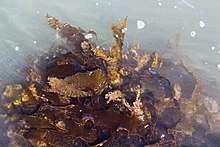Ecklonia radiata
Ecklonia radiata is a species of kelp found in the Canary Islands, the Cape Verde Islands, Madagascar, Mauritania, Senegal, South Africa, Oman, southern Australia, Lord Howe Island, and New Zealand.[3][4]
| Ecklonia radiata | |
|---|---|
 | |
| Barangaroo, Australia | |
| Scientific classification | |
| Kingdom: | Chromista |
| Phylum: | Ochrophyta |
| Class: | Phaeophyceae |
| Order: | Laminariales |
| Family: | Lessoniaceae |
| Genus: | Ecklonia |
| Species: | E. radiata |
| Binomial name | |
| Ecklonia radiata | |
| Synonyms[2] | |
Ecklonia radiata grows in kelp beds on reefs and where sheltered can form dense 'forests'.[5][4] It can be found in the low intertidal zone to depths of approximately 25m.[4]
References links
| Wikimedia Commons has media related to Ecklonia radiata. |
- "Ecklonia radiata (C.Agardh.) J.Agardh". Manaaki Whenua Landcare Research. Retrieved 27 January 2018.
- Guiry, Michael D. (2015). "Ecklonia radiata (C.Agardh) J.Agardh, 1848". WoRMS. World Register of Marine Species. Retrieved 9 June 2019.
- Guiry, M. D. (2019). "Ecklonia radiata (C.Agardh) J.Agardh :: Algaebase". www.algaebase.org. National University of Ireland, Galway. Retrieved 2019-01-26.
- Nelson, W. A. (2013). New Zealand seaweeds : an illustrated guide. Wellington, New Zealand: Te Papa Press. p. 96. ISBN 9780987668813. OCLC 841897290.
- Toohey, Benjamin D.; Kendrick, Gary A. (2008-05-01). "Canopy–understorey relationships are mediated by reef topography in Ecklonia radiata kelp beds". European Journal of Phycology. 43 (2): 133–142. doi:10.1080/09670260701770554 – via Researchgate.
gollark: I think the general answer is "ad revenue to the site", but I think there's an adblocker which fakes ad clicks or something.
gollark: Are those even legally binding?
gollark: How many of those actually say "pay attention to the adverts or else"?
gollark: Am I required to look at billboards if I happen to be in an "urban center"?
gollark: Why is adblock not fine but e.g. ignoring adverts (to the extent that you can do that) not not?
This article is issued from Wikipedia. The text is licensed under Creative Commons - Attribution - Sharealike. Additional terms may apply for the media files.